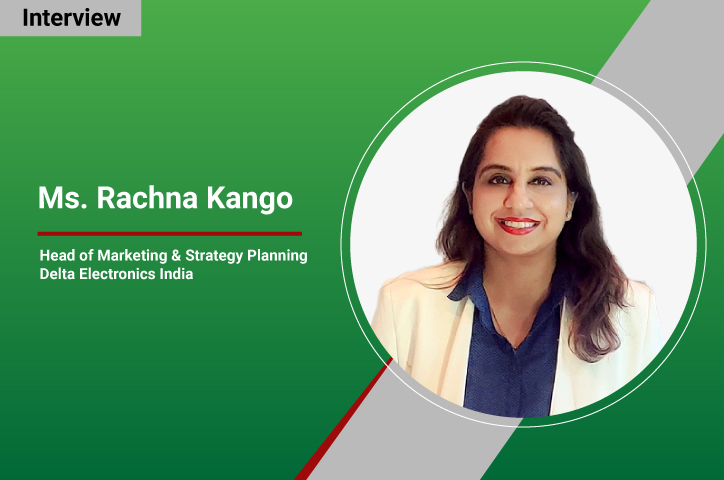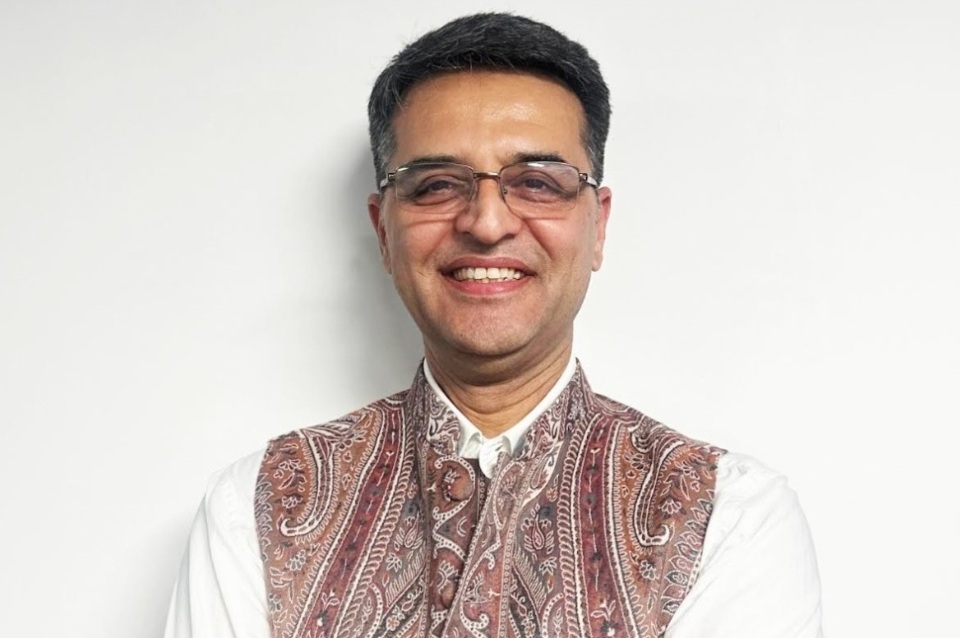Real estate sector is responsible for 40% of global greenhouse gas emissions. Feeling the urgency of reducing the carbon footprints and become sustainable, the sector is embracing green and eco-friendly homes. Sustainable materials, responsible sourcing, and water-efficient technologies are being used to mitigate the environmental damage created by the sector. Among other players, Delta Electronics India, a leading Power and Energy management company, is pioneering the way towards sustainable and green homes. Delta Electronics has created 32 green buildings worldwide since 2006 to promote environmental, social and health benefits of green buildings using green and energy-efficient technologies. The firm is also working with the Indian government to develop an extensive and sustainable EV charging ecosystem.
In this conversation with TheCSRUniverse, Rachna Kango, Head of Marketing and Strategy Planning, Delta Electronics India shares the company’s CSR initiatives and their sustainable methodologies.
Excerpts from the Interview:
Q. Tell us about your ongoing and upcoming projects in India. How are you ensuring that they are sustainable?
A. We prioritize renewable energy by installing solar panels on our office buildings and warehouses. This enables us to generate clean electricity, reduce our dependence on fossil fuels, and significantly lower carbon emissions. By embracing solar energy, we contribute to a greener and more sustainable energy landscape.
Ensuring sustainability is of utmost importance to us. We have specific criteria in place that guide and evaluate our projects. These criteria encompass the use of renewable energy sources, the adoption of water-saving technologies, waste reduction measures, and the improvement of working conditions. By adhering to these sustainability guidelines, we guarantee that our projects align with best practices and contribute to a more sustainable world.
We have set ambitious goals to reduce greenhouse gas emissions by 20% by 2025, emphasizing our commitment to combatting climate change and creating a cleaner environment. As proud members of RE100, a global initiative committed to 100% renewable energy, we actively support the transition to sustainable energy solutions.
Water conservation is another area where we have made significant progress. Through our water conservation program, we have achieved a substantial 20% reduction in water usage. This program reflects our responsible water management practices and contributes to the sustainable utilization of this vital resource.
Moreover, as a member of the Ethical Trading Initiative, we uphold fair labor standards and actively promote social sustainability in our projects and supply chains. Collectively, our ongoing and upcoming projects, coupled with our sustainability initiatives, demonstrate our active contribution to a more prosperous and sustainable future for India. At Delta Electronics India, we are dedicated to making a positive impact on the environment, society, and the overall well-being of the communities we serve.
Q. As India is embracing EV revolution, vehicular charging stations is a big challenge to address. Is your company working with the government to help address this?
A. Yes, as a leading provider of power and automation solutions, Delta Electronics India recognizes the significance of the EV revolution in India. We understand that the development of vehicular charging infrastructure is crucial for the successful adoption of electric vehicles (EVs) across the country. In line with this understanding, we are actively collaborating with the government to address the challenge of vehicular charging stations. We believe that a robust charging infrastructure is essential to support the growing number of EVs and encourage their widespread adoption.
We are involved in initiatives aimed at expanding the EV charging network in India. We contribute our expertise in power electronics and energy management to develop innovative and efficient charging solutions. Our goal is to ensure that EV owners have convenient access to reliable and fast-charging infrastructure, enabling seamless and hassle-free EV charging experiences.
By working closely with the government and its partner agency, we aim to contribute to the development of an extensive and sustainable EV charging ecosystem in India.
Q. What measures should the government take to quickly transition towards EVs?
A. To expedite the transition towards electric vehicles (EVs), governments should implement a comprehensive set of measures. Firstly, they should provide financial incentives and subsidies to make EVs more affordable for consumers. These incentives can include tax benefits, purchase rebates, and reduced registration fees. Additionally, governments should invest in the development of a robust charging infrastructure network, ensuring widespread access to charging stations in public spaces, residential areas, and along highways. Promoting research and development in EV technology is crucial, as it can drive innovation and improve battery technology and charging solutions. Public transportation electrification should be a priority, encouraging the adoption of EVs in buses, taxis, and other shared transportation systems. Raising awareness about the benefits of EVs through educational campaigns is essential to dispel misconceptions and encourage consumer acceptance. Governments should also introduce supportive regulations and policies, such as emission standards, preferential parking or toll benefits for EVs, and streamlined permitting processes for charging infrastructure installation. Collaboration and partnerships with private companies and stakeholders are vital to accelerate the EV transition, as they can leverage expertise and resources to develop and implement effective strategies. Ultimately, a holistic approach that encompasses incentives, infrastructure development, research, education, regulation, and collaboration will drive a swift and successful transition towards EVs.
Q. Delta has created 32 green buildings worldwide since 2006 to promote the environmental, social and health benefits of green buildings. Several of these green buildings have been donated to academic institutions to inspire next generations to foster sustainable development. Could you share your learnings with us for the benefit of our readers?
A. Delta Electronics has a strong commitment to promoting sustainable development through the creation of 32 green buildings worldwide since 2006. These buildings have played a crucial role in showcasing the environmental, social, and health benefits associated with green architecture. Moreover, we have generously donated several of these green buildings to academic institutions with the aim of inspiring and educating the next generation about sustainable development. Our experience in creating and donating these green buildings has provided us with valuable insights. We have learned that energy efficiency is a key focus in green buildings, achieved through the implementation of advanced technologies and design strategies such as energy-efficient lighting systems, optimized HVAC systems, and smart energy management solutions. By maximizing energy efficiency, green buildings minimize energy consumption and reduce their carbon footprint.
Another crucial aspect of green buildings is the integration of renewable energy sources. By incorporating solar panels, wind turbines, and other renewable energy systems, these buildings generate clean and sustainable energy. This not only reduces dependence on traditional energy sources but also contributes to a more sustainable energy landscape.Sustainable materials and construction practices are essential components of green buildings. By prioritizing the use of eco-friendly materials, such as recycled content, responsibly sourced wood, low VOC paints, and sustainable insulation, green buildings minimize environmental impact and promote healthier indoor air quality.
Water conservation is also a significant consideration in green buildings. Implementing water-saving technologies and practices, such as efficient plumbing fixtures, rainwater harvesting systems, and wastewater treatment and recycling, helps minimize water consumption and promote responsible water management. Furthermore, green buildings prioritize creating a healthy indoor environment for occupants. This includes incorporating features like ample natural light, good ventilation systems, and low-emission materials. These factors contribute to a comfortable and healthy indoor environment, enhancing occupant well-being and productivity while reducing negative health impacts.
Our experience in creating and donating green buildings has taught us the importance of adopting holistic and integrated approaches to sustainable development. By incorporating energy efficiency, renewable energy, sustainable materials, water conservation, healthy indoor environments, and educational initiatives, green buildings can make a significant positive impact on the environment, society, and the well-being of individuals.
Q. Delta’s unique location in the Bay Area takes advantage of the natural underground warm springs. With over 20 miles of horizontal piping at 15 and 30 feet depths, a VFD circulates water in a closed-loop system to exchange heat for an HVAC system estimated to be 70% more efficient than a cooling tower. Could you throw more light on this technology and share its environment impact as well?
A. Delta Electronics' location in the Bay Area provides a unique opportunity to leverage the natural underground warm springs for sustainable heating and cooling solutions. The company has implemented an innovative technology that utilizes over 20 miles of horizontal piping at depths of 15 and 30 feet. Through a variable frequency drive (VFD), water circulates in a closed-loop system, exchanging heat for an HVAC system. This system is estimated to be 70% more efficient than traditional cooling towers.
The technology employed by Delta Electronics taps into the thermal energy present in the natural underground warm springs. By utilizing this geothermal heat source, the company reduces its reliance on conventional cooling methods, which typically require large amounts of energy and contribute to greenhouse gas emissions. The closed-loop system effectively captures and utilizes the thermal energy, providing an efficient and sustainable solution for heating and cooling needs.
The environmental impact of Delta Electronics' geothermal-based HVAC system is significant. By operating at a higher level of efficiency compared to traditional cooling towers, the technology minimizes energy consumption and reduces the associated carbon footprint. Additionally, the closed-loop system eliminates the need for water-intensive cooling towers, which reduces water consumption and preserves this precious resource. By opting for a sustainable and resource-efficient solution, Delta Electronics demonstrates its commitment to environmental stewardship.The use of geothermal energy for heating and cooling also has indirect environmental benefits. By reducing reliance on fossil fuel-based energy sources, the technology helps decrease the demand for traditional energy generation, which often involves the burning of fossil fuels and the release of pollutants. This leads to improved air quality and a healthier environment for both Delta Electronics and the surrounding community.
Delta Electronics' implementation of geothermal-based HVAC technology utilizing natural underground warm springs demonstrates the company's commitment to sustainable and efficient solutions. By leveraging this innovative system, Delta Electronics significantly reduces energy consumption, greenhouse gas emissions, and water usage. This technology serves as a prime example of how companies can harness natural resources in an environmentally responsible manner, making a positive impact on both the local and global environment.
Q. The real estate sector is far from adapting environmentally-sustainable solutions that can address the biggest issue of climate change and global warming. What measures should the realty sector take in this regard?
A. The real estate sector has a critical role in addressing climate change and global warming. To promote environmental sustainability, the sector should prioritize energy efficiency through efficient design, advanced technologies, and smart energy management. Integration of renewable energy sources such as solar panels and wind turbines can reduce reliance on fossil fuels. Sustainable materials, responsible sourcing, and water-efficient technologies contribute to minimizing environmental impact and enhancing indoor quality. Incorporating green infrastructure and landscaping features helps mitigate urban heat effects and improve biodiversity. Education and awareness programs are essential for fostering a culture of sustainability among developers, professionals, and occupants. By embracing these measures, the real estate sector can create sustainable communities and reduce the environmental footprint of the built environment.
Q. What’s Delta’s next-generation SCADA system and building control platform?
A. Delta's next-generation SCADA system and building control platform, known as the Delta Building Management and Energy Saving System (BMES), offers comprehensive control and management of building systems for optimal energy efficiency and comfort. It monitors and optimizes HVAC, lighting, power distribution, and renewable energy sources using advanced sensors, controllers, and communication protocols. Facility managers can efficiently manage energy consumption, analyze usage patterns, and implement energy-saving strategies through automated scheduling, occupancy sensing, and demand response capabilities. The SCADA component enables remote monitoring and control, providing real-time data visualization and analysis. Integration with building automation systems enhances efficiency and coordination. The Delta BMES enables significant energy savings, cost reduction, and a more sustainable built environment, showcasing Delta's commitment to innovative solutions for energy efficiency and sustainability.
Q. Why do you think that buyers are investing more in green housing projects?
A. Buyers are increasingly investing in green housing projects for several reasons. Firstly, environmental awareness and concern for sustainable living have gained significant traction in recent years. People are becoming more conscious of the impact their actions have on the planet and are seeking ways to reduce their carbon footprint. Green housing projects offer an opportunity for individuals to contribute to environmental preservation by living in homes that are designed and constructed with sustainability in mind.
Secondly, green housing projects often provide long-term cost savings for homeowners. Energy-efficient features such as solar panels, efficient insulation, and smart technologies can significantly reduce energy consumption, leading to lower utility bills. Additionally, water-saving fixtures and systems can reduce water usage and associated costs. Over time, these savings can offset the initial investment, making green housing financially appealing.
Furthermore, green housing projects prioritize occupant health and well-being. They often incorporate features such as improved indoor air quality, ample natural lighting, and efficient ventilation systems, creating a healthier living environment. Buyers are increasingly recognizing the value of living in homes that promote their physical and mental well-being.
Additionally, green housing projects are often associated with higher property values and market demand. As sustainability becomes a more influential factor in purchasing decisions, homes with green certifications or environmentally-friendly features tend to attract a larger pool of interested buyers. This increased demand can result in greater property appreciation and resale value. Lastly, government incentives and regulations have also played a role in driving buyer interest in green housing projects. Many governments offer financial incentives, tax benefits, and subsidies to encourage the adoption of sustainable practices in the real estate sector. These incentives make green housing more affordable and financially attractive for buyers.
Q. Apart from being responsible for nearly 39% of carbon emissions, land contamination is one of the biggest challenges that the realty sector creates. What solutions do you suggest in this regard?
A. Addressing land contamination in the realty sector is crucial for promoting environmental sustainability. To mitigate this challenge, several solutions can be implemented. Firstly, conducting thorough environmental assessments and site investigations before commencing any construction or development can identify potential contamination sources and allow for remediation plans. Implementing sustainable land management practices, such as brownfield redevelopment, can repurpose previously contaminated sites, reducing the need for further land acquisition and preventing the expansion of urban sprawl. Promoting the use of environmentally-friendly construction materials and techniques can minimize the release of hazardous substances into the environment. Additionally, implementing effective waste management systems on construction sites can reduce the generation of construction and demolition waste, ensuring proper disposal or recycling of materials. Collaborating with environmental experts, regulators, and local communities can facilitate knowledge-sharing and create a comprehensive framework for addressing land contamination challenges. By integrating these solutions, the realty sector can contribute to sustainable land use, preserve natural resources, and mitigate the environmental impact associated with land contamination.
Q. Associating terms like eco-friendly, green, sustainable, environment-friendly with the real estate is a fashion and advertisement gimmick too. To what extent does greenwashing exist in the construction sector?
A. Greenwashing, the practice of making misleading or unsubstantiated claims about the environmental benefits of products or services, does exist to some extent in the construction sector. As terms like eco-friendly, green, sustainable, and environment-friendly gain popularity, some companies may exploit these terms for marketing purposes without genuinely adopting sustainable practices. Greenwashing in the construction sector can manifest in various forms, such as using environmentally friendly buzzwords without implementing substantive changes, exaggerating or misrepresenting the environmental impact of projects, or selectively highlighting minor green initiatives while neglecting larger environmental concerns. It is essential for stakeholders in the construction sector, including consumers, regulators, and industry organizations, to remain vigilant and demand transparency and accountability from companies. Recognizing credible certifications, conducting independent evaluations, and engaging with reputable sustainability standards can help distinguish genuine sustainable practices from greenwashing. Creating industry-wide regulations and guidelines to define and enforce green claims can also play a significant role in mitigating greenwashing practices. By addressing greenwashing, the construction sector can ensure that sustainability claims are backed by tangible actions, fostering a truly sustainable and responsible industry.
Q. How do you integrate and ensure ESG in your projects?
A. At Delta Electronics, we have a strong commitment to integrating and ensuring Environmental, Social, and Governance (ESG) principles in all our projects. We understand that sustainability encompasses not only environmental aspects but also social and governance dimensions. To achieve this, we adopt a comprehensive approach that encompasses key practices such as environmental responsibility, social sustainability, governance practices, stakeholder engagement, and reporting and disclosure. In terms of environmental responsibility, we focus on minimizing the environmental impact of our projects by incorporating energy-efficient technologies, utilizing renewable energy sources, and embracing sustainable materials. Our goal is to reduce carbon emissions, promote resource efficiency, and safeguard biodiversity.
For social sustainability, we prioritize the well-being and safety of our employees, contractors, and stakeholders. We provide an inclusive work environment, promote fair labor practices, engage with local communities, and contribute to their development. We uphold human rights, support diversity and inclusion, and strive to enhance the social progress of the communities we operate in.
In terms of governance practices, we maintain robust internal control systems, ensure transparency and accountability, and uphold ethical conduct in all our projects. We comply with relevant laws and regulations, prevent corruption, promote integrity, and safeguard the interests of our stakeholders.
Stakeholder engagement is a crucial aspect of our approach. We actively involve and collaborate with our stakeholders, including local communities, customers, suppliers, and investors. By seeking their input, addressing their concerns, and considering diverse perspectives, we ensure that our projects align with their needs and expectations.
We also maintain a strong reporting and disclosure framework to communicate our ESG performance and progress. Following internationally recognized reporting standards such as the Global Reporting Initiative (GRI) and Sustainability Accounting Standards Board (SASB), we provide transparent and comprehensive information to our stakeholders.
Through our commitment to integrating and assuring ESG in our projects, we aim to create long-term value for not only our company but also the environment and society. By considering the environmental, social, and governance aspects, we strive to deliver sustainable solutions that contribute to a more prosperous and resilient future.















.jpg)




